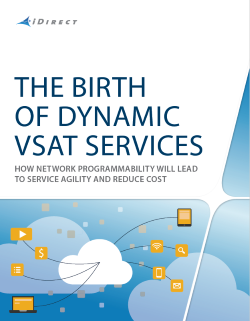Satellite service providers are being challenged by the demand for value-added services, the increasing complexity of networks, and increasing operational costs. These three forces are creating an environment where service providers have unlimited potential for growth, but the cost structure to sustain that growth means the opportunity is becoming less profitable.
The VSAT industry needs a new approach to resolve this situation, one offered through Software Defined Networking (SDN) and Network Function Virtualization (NFV). Since adopting network programmability means embracing automation and virtualization, it  promises to satisfy the forces by:
promises to satisfy the forces by:
- Improving agility for supplying value-added services,
- Making network complexity manageable, and
- Achieving this while reducing operational cost.
Each of these outcomes are critical to future success and they are logically linked to each other. If the complexity is better managed, then companies become more agile. Better agility also boosts productivity, which leads to a reduction in expenses.
Network programmability encourages business to focus on investing in infrastructure solutions that lead to dynamic service capabilities and a reduction in operating expenses (OpEx). A service provider that implements network programmability directly cuts manual processes and consolidates network hardware, leading to positive operational impacts such as:
- Less facility space, resulting in less power and cooling requirements
- Systems scale precisely to demand, rather than being overprovisioned
- Traffic is engineered and optimized precisely as desired
- Less personnel are required to configure and maintain systems
- Network is centrally managed with better visibility
- New services are deployed in minutes rather than weeks
- Services are flexibly tailored to satisfy each customer
Not only do these benefits make logical sense, they are proven operational outcomes. Last year, Cisco Systems completed a research study to determine the real-life results of automating network services. They found that across dozens of terrestrial service providers who had invested in network orchestration, the overall savings in OpEx for adding customers, resolving incidents, implementing changes, and conducting maintenance was between 50% and 70%.1
Those VSAT providers that begin transitioning toward SDN and NFV have much to gain. iDirect has written a special white paper to help satellite service providers understand the concepts of SDN and NFV, discover how this technology will be critical to future growth, and learn how companies can take the first steps forward toward adopting network programmability.
Begin preparing for the SDN and NFV technology transition by downloading The Birth of Dynamic VSAT Services white paper.
1 The Business Benefits of Automation and Orchestration. White Paper, Cisco Systems, 2016.
